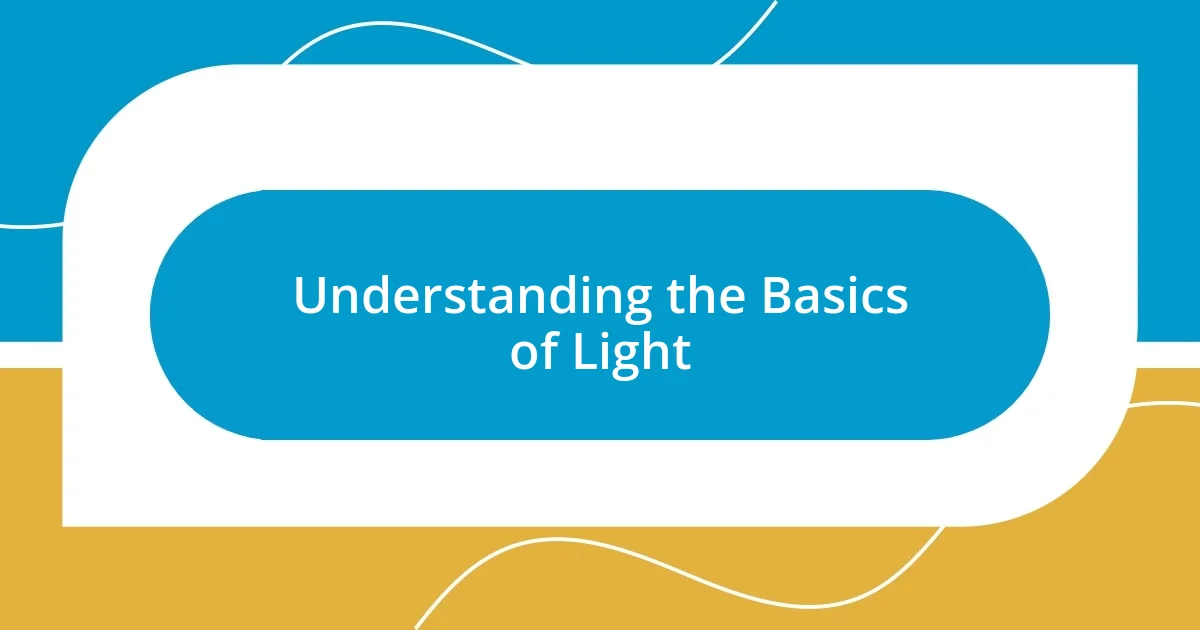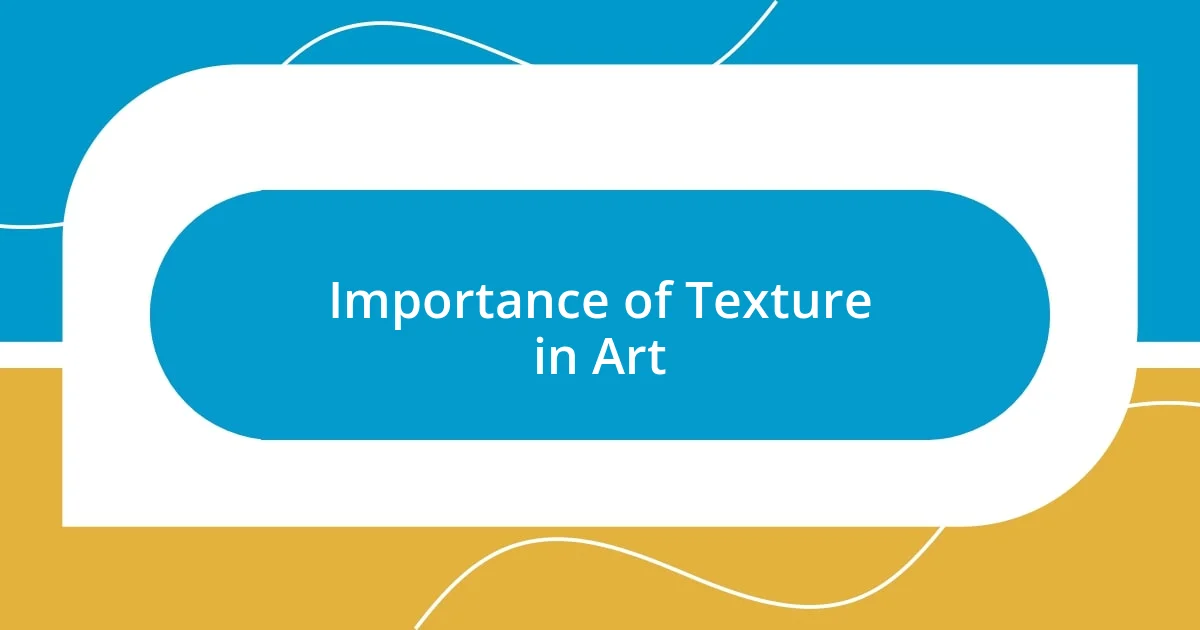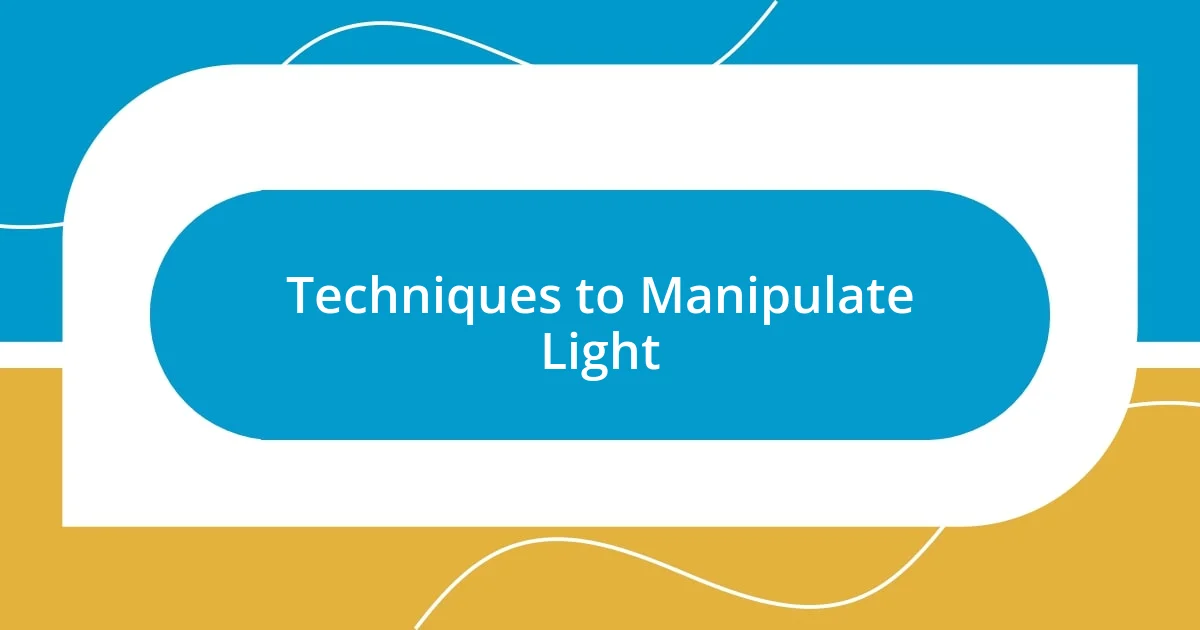Key takeaways:
- Light interacts with surfaces to affect our perception of texture, revealing hidden elements and enhancing the emotional depth of artworks.
- Texture in art engages viewers on a sensory level, influencing emotions and creating visual interest, depth, and a unique narrative.
- Combining different lighting techniques with varied textures can dramatically reshape the storytelling and emotional resonance of a piece of art.

Understanding the Basics of Light
Light is fundamentally fascinating. It’s not just a physical phenomenon; it can evoke emotions and set moods. Think about the last time you walked into a room flooded with warm sunlight. How did it make you feel? Personally, I find that light can transform the ambiance of any space.
When exploring light, it’s essential to understand that it travels in waves, but it also behaves like a particle. This duality is something I find particularly intriguing. There was a moment when I was experimenting with photography, squinting at the sunset, and realizing how the varying wavelengths produced different colors. It’s an awe-inspiring reminder of how something so simple can create such vivid beauty.
Moreover, the way light interacts with surfaces—reflecting, refracting, and absorbing—affects how we perceive texture. I often ponder how a polished surface versus a matte finish can change our experience of a piece of art. Have you ever thought about the texture of a sculpture under different lighting? It can bring out details we might overlook in a dim room, making the artwork come alive. In my experience, lighting can unveil hidden dimensions, inviting us to delve deeper into the textures surrounding us.

Importance of Texture in Art
Texture plays a crucial role in art, influencing both the aesthetic appeal and emotional depth of a piece. I remember standing in front of a large canvas at an art gallery, where the artist had layered thick paint to create a tactile surface. It drew me in, making me want to reach out and touch it. That experience highlighted for me how texture can evoke a visceral response, stirring emotions that a smooth painting simply might not.
Consider these aspects of texture and its significance in art:
- Tactile Engagement: Texture invites the viewer to explore with their senses, even if they can’t physically touch the artwork.
- Emotional Resonance: Different textures can evoke various feelings; rough surfaces may suggest turmoil, while soft ones can provide comfort.
- Visual Interest: Texture can draw the viewer’s eye in and create a unique visual narrative that enhances the story behind the work.
- Depth and Dimension: Texture adds layers to a piece, often revealing hidden elements when examined closely, allowing for a more immersive experience.
Reflecting on my interactions with texture in art has deepened my appreciation for how it can shift our perception and understanding.

Techniques to Manipulate Light
Manipulating light is a skill that can dramatically enhance the visual storytelling of any artwork. One technique I often experiment with is the use of natural light versus artificial light. I recall a day when I positioned a sculpture by a window, allowing the sunlight to cast intricate shadows on the surface. The interplay of light and texture became a vibrant dance, transforming a simple piece into an ethereal experience. It’s moments like these that remind me how the time of day can reshape our perception of art.
Another method I find fascinating is the use of filters and gels in photography. When I first experimented with colored gels, the results were astonishing. A mere light change could evoke different emotions, shifting a serene scene to one that felt charged with energy. It’s a powerful reminder that even small adjustments can shape the narrative we’re trying to convey. Have you ever played with filters? You might be surprised by the emotional responses they can elicit.
Lastly, directional lighting is an essential technique I’ve mastered to emphasize texture. Whether it’s using side lighting to reveal details or backlighting to create a silhouette effect, I love manipulating these angles to tell a story. I remember a time freeze-framing my friend’s portrait against varying light directions; the textures on their face told tales of joy and life experience. Each light angle pulled the texture into focus, creating an entirely different emotional connection with the viewer. It’s incredible how light can become a storyteller all on its own.
| Technique | Description |
|---|---|
| Natural vs. Artificial Light | Using sunlight to create dynamic shadows or artificial light to maintain control over the scene. |
| Filters and Gels | Coloring light can dramatically alter the mood of an image or artwork. |
| Directional Lighting | Adjusting light angles to highlight textures, adding depth and emotional resonance to the piece. |

Exploring Different Textures in Mediums
When exploring different textures in mediums, I often find myself gravitating towards mixed media. For instance, blending materials like sand, fabric, or even natural elements can create depth and intrigue. I once incorporated sea glass into a collage, and the way the light refracted off each piece added an unexpected layer of complexity. Have you ever seen how a rough texture can transform a soft canvas into a landscape of emotions? It’s fascinating how juxtaposing such elements can evoke a multifaceted response.
I also love working with clay, as its inherent texture offers endless possibilities. The tactile experience of molding and carving brings me joy, reminding me of childhood days spent playing in the mud. Recently, I sculpted a piece that featured both smooth and jagged surfaces, creating a dialogue between chaos and calmness. Each texture contributed to the sculpture’s narrative, inviting viewers to interpret it through their own experiences. Isn’t it intriguing how some textures can instantly stir nostalgia or provoke a sense of curiosity?
Another medium that stands out for its texture is watercolor. The fluidity of the paint combined with the texture of the paper creates a dynamic interplay. I once experimented with wet-on-wet techniques, observing how colors merged and formed unique textures that resembled landscapes. The unpredictability of the medium excites me—it’s like a conversation where the paper and paint respond to each other. Have you had a moment where a medium surprised you with its own voice? Those are the moments that truly enrich my artistic journey.

Combining Light and Texture Together
The fusion of light and texture can create magical moments in art, revealing dimensions that might otherwise remain hidden. I remember one evening when I decided to experiment with a piece that featured rough burlap as the base. As the golden hour approached, the setting sun illuminated the texture, casting fascinating reflections that brought the fabric to life. Have you ever noticed how the light can reveal hidden details that stir a deeper emotional response?
In my experience, using contrasting textures in conjunction with light can amplify the narrative of a piece. During my last project, I layered smooth acrylics over coarse charcoal, which was illuminated by a strong spotlight. The contrasting elements not only caught the light differently but also evoked a visual dialogue between chaos and tranquility. This juxtaposition made me realize how essential it is to be intentional with both texture and light to achieve emotional depth. Have you ever felt that a simple shift in light could completely alter your emotional perception of an artwork?
Creating depth doesn’t stop at the choice of paired textures; the direction and quality of light play a significant role too. Recently, I worked on a series of paintings where I employed harsh, direct light versus softer diffused lighting. The texture seemed to breathe under these varying conditions, with sharp shadows creating a sense of drama in one piece, while another felt serene and inviting under softer illumination. It was a revelation; how many interpretations can arise from a single work based solely on lighting? The interplay between these two elements is truly a dance that enhances the storytelling in art.

Case Studies of Successful Works
Exploring real-world examples of artworks that skillfully blend light and texture reveals fascinating insights into the creative process. I remember attending an exhibition where an artist combined metallic paint and textured canvases. The way the light bounced off the surfaces created a shimmering effect that grabbed my attention. It made me ponder – have you ever stood in front of a piece that felt alive, almost communicating with you through its texture and finish?
Another stunning case study is a local mural I encountered that incorporated three-dimensional elements. The artist used layered materials and strategically placed lights, which transformed the mural throughout the day. Watching it change from vibrant hues in the sunlight to a more muted palette at dusk was an emotional experience. Isn’t it captivating how light can morph the narrative of a work and influence our emotions as viewers?
A personal project I engaged in involved taking photographs of textured surfaces under varying light conditions. One particular image featured the rugged bark of an old tree, where the late afternoon sunlight highlighted every groove and shadow. It was a moment of clarity that taught me the significance of timing in art. Do you ever consider how the time of day can alter not just the light but the entire essence of texture in your creations? Now, I approach my art with a newfound appreciation for the dance of light and texture, knowing they are partners in telling compelling stories.














